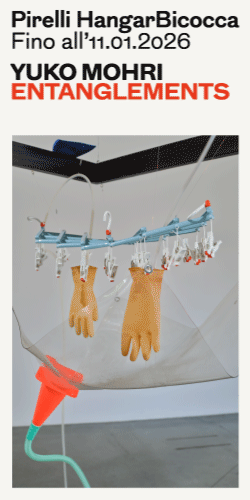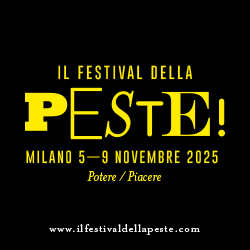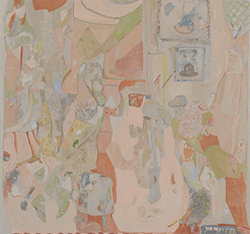[nemus_slider id=”53348″]
For her first solo exhibition at the Gió Marconi Gallery, Allison Katz (b. 1980) created a site-specific architecture, installing her paintings among a series of triangulated temporary walls. By staging a series of revealing and concealing angles, the exhibition becomes a double path, allowing the viewer to experience contrasting visions within the same space. ATPdiary, in collaboration with Marta Ravasi, asked the artist some questions.
ATP: Your practice is a complex structure of relations: the works are both linked to the History of Western Painting and to a personal, perhaps uncanny symbolic system. I have always found the titles of your shows particularly exciting, almost as they played a very specific role within these references, I am thinking in particular to “All Is On”, from your last show at Kunstverein Freiburg (Sep. 2015) and to “Regardless” from your first solo in London at the Laura Bartlett Gallery (2013); they helped decoding your language and matching these relations into correspondences. What is the AKA story?
Allison Katz: The story is naming. “All Is On” is a breakdown of my name, into the three words it is composed of. “AKA” stands for also known as, it is what precedes pseudonyms, nicknames, aliases, or to show the subject was known or named at another time or place; they are also my initials, set in rotation, a palindrome, returning to itself rhythmically as it opens up to the possibility of alternate names. It’s interesting to me that you mention “Regardless.” Regardless is an adverb, it means simply anyway, despite everything, it is defiant and heedless; but I chose it specifically because I encountered it as a name. It is the name of a small fishing vessel, which I saw by chance resting in the harbour of the Orford river in Suffolk. We give names to everything, bodies, animals, places, storms, planets, books; they enable relationships and data to form through nebula and chaos. A name straightens out formlessness and gives identity. I would like to show how this is true and human, and at the same time a form of deception.
An exhibition is temporal, the works are brought together in an unstable body and will then be dispersed. It is an episode, not a narrative. Any title charges the episode with ambiance, but I also want to bring attention back to the basic act of naming itself, an act of creation as much as a painting. I think of Ptah, the Egyptian counterpart to Adam: Ptah conceives the world by the Thought of his heart and gives life through the magic of his Word. Or, tongue naming everything, thereby bringing it into existence. “AKA” introduces the possibility of dissent, mischief, disorder, by implying that names contain multiples, so language and meaning must be seen as fluid. The distinction between an inherited and an invented identity – what is art if not this? – blurs, expands or shatters into double-meanings, misunderstandings, slips and layers. The Italian writer known as Elena Ferrante (it is a pseudonym, no one knows her real name or identity) eloquently stated in one of her letters: “the mystery of literature is in some ways its difference from the person who wrote it, the unfathomable effacement of self that leads to its creation.” I would argue that the artist questioning her own name is the first act required to release content.
Finally “All Is On, ” which opened in September 2015, released a series of postscripts, and while not exactly the same, I saw it as being similar to the way a novel might come out in 4 parts, or a TV plot is meted out over a season. The first coda was 2 paintings and a poster presented as week 47/50 of fig-2 at the ICA Studio London in November, followed by “AKA” in Milan in February, and finishing with a presentation at Independent in New York in March. Certain paintings carried over, shown in different cities, while some subjects reappear with mutations. Its a way of getting at the subject from a different angle, while at the same time saying, there is no subject, or the subject is not what it appears to be. Its a way of making the viewer look. It is also an attempt to inject mobility into the presumed stability of a painting; there can be as assumption that its not necessary to see a painting again, as if its a fixed autonomous object, but in different installations and surroundings, it emits different meanings.

ATP: Your language develops in many media: paintings, ceramics, sculptures, posters. In some occasions they dealt with the exhibition space itself directly, I am thinking of the fresco painting made on the occasion of “Perra Perdida” at Lulu (2014) or of your Tussie Mussie Screen. For “AKA” you worked on the space of the Gallery creating an almost scenic and theatre-like environment. What is behind this choice?
AK: “All Is On” was in a completely open space, a Kunstverein in a former Nazi pool, I didn’t wish to hide anything, I hung the paintings and forced them to do the hard work of intimacy, of turning the cold space hot, without any embellishment. I was thinking of Bonnard’s idea when he said that he was “trying to do what I have never done, give the impression one has on entering a room: one sees everything and at the same time nothing.” I appreciated the luxury of that space, the echo the body made moving around it, how the scale humbled even my large paintings and the ambition of the viewer to connect them.
In all the subsequent iterations therefore, I focused on the walls. Walls that worked in some mirror capacity to the paintings. For fig-2 at the ICA Studio I created two monolithic walls, that were placed at incongruous angles. There was only one position from which you could see both paintings, otherwise you could only see one at a time, or no paintings at all, just blank space. From this design I moved onto the idea for “AKA”: three distinctly angled folds that resembled screens, triangular outcroppings that hid their depths. I wanted to combine the elemental hot and cold situation that occurred in the vast Kunstverein hall, with the hide and seek that developed in the small ICA space. I hoped to make a show that embodied the wild and contradictory nature of the body, without revealing everything at once, that operated however simultaneously. This is also why I invoked Schrödinger’s Cat in one of the exhibition’s posters: the pun on my name only serves to emphasise the impossibility of knowing whether the cat is alive or dead – at a certain point in the thought experiment, the certainty splits and is divided, with both options simultaneously possible – and this could also be said of the entire tradition of painting itself too! One has to deal with the inability to draw a conclusion.
With help from the designer Caitlin Tobiasz, I envisioned the exhibition as a two-way route that could be read forward and backward, reflecting the palindrome of “AKA, ” by presenting the viewer with two different exhibitions, depending on if they are standing by the door, looking towards the back wall, or vice-versa. The first view is of paintings that are all extremely hot and charged with intense colours, and only 4 of the 10 works are visible; from the opposite position, a different 4 works are apparent, and they are all much cooler, drawn, muted, cerebral. I insist it is the same force, like a Janus head. As you walk around and through the geometry softens and the opposing paintings are united but only through glimpses at odd angles. The cooperation is suspended, the paintings cannot face each other. It somehow suits my most recent favourite quote, by Marion Stancioff, “Warning! Symbolism is not a cocktail, but an ocean.”
ATP: The choice of your images feels always unexpected and the way you paint very free, like if all happens very fast. This is maybe wrong, as your work is ambiguous, both eccentric and calibrated; but are you fast and free as I suspect?
AK: It is not entirely wrong, but fast and free is the opposite of how I work. Some paintings can take over two years to complete. Some are done in a matter of hours. The crucial point is to admit there is no subject. There are layers, and if the final one is fast, it often could only be so because of the archeology underneath, or because it is surrounded by paintings at varying stages of completion, or because someone said something to trigger the next move. I am not one to relish process, or idealise a struggle, of course I wish I could be fast and free, that remains a sort of recent ideal in culture, perhaps from rock and roll. The only freedom I know comes from giving up, giving in, to time; what is fast is the knowledge of the gut, that winces forcefully when something isn’t done, when something is falsified or vain or pretentious.
ATP: I think you are in an enviable position, any advice to young painters?
AK: Well, I consider myself a young painter, and lately I am taking advice from Laurie Anderson and Lou Reed. Many years back they decided they needed some rules, that life was going by so fast, they had hardly any time to think, ‘what should I do? what should I think? how to act quickly?’ So they devised 3 simple rules to live by, and with their help, you won’t have to overthink, just try to do your best:
1. Don’t be afraid of anybody
2. Get a good bullshit detector and learn how to use it
3. Be really tender












